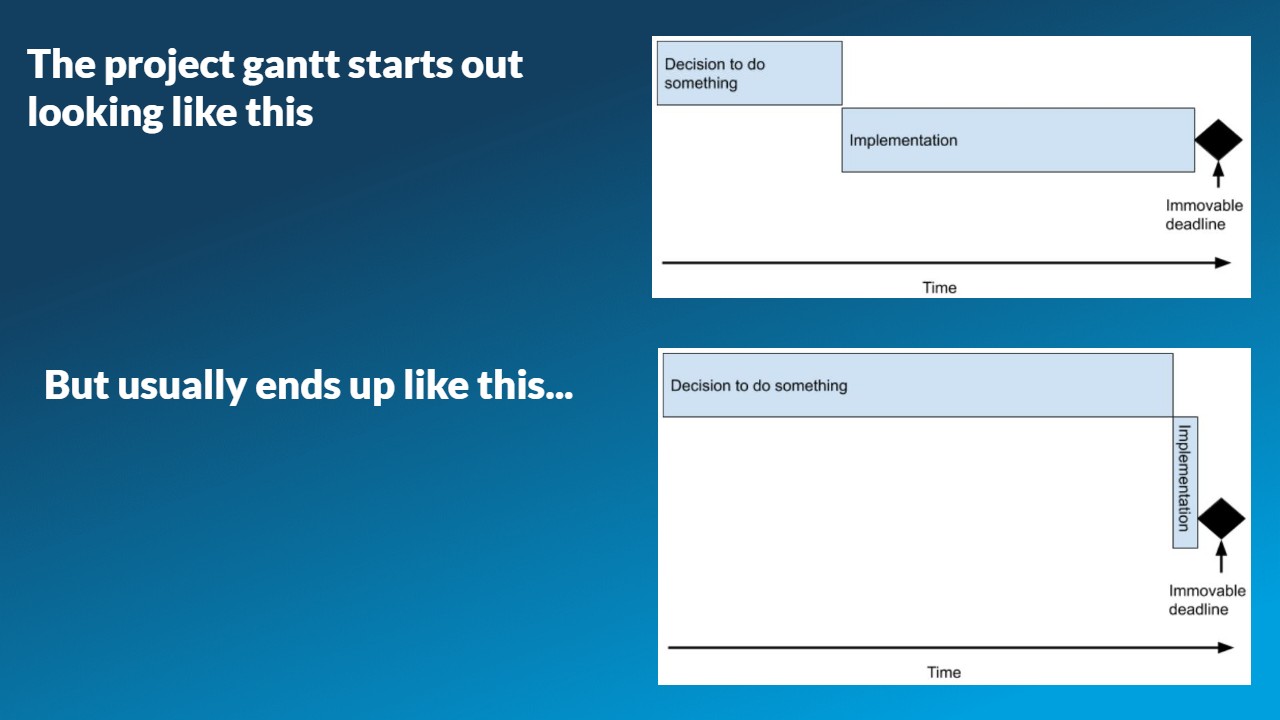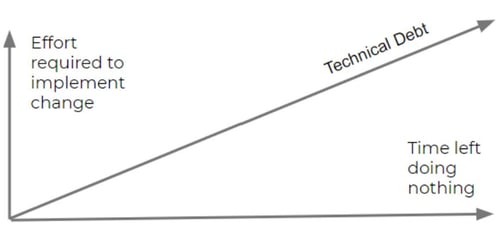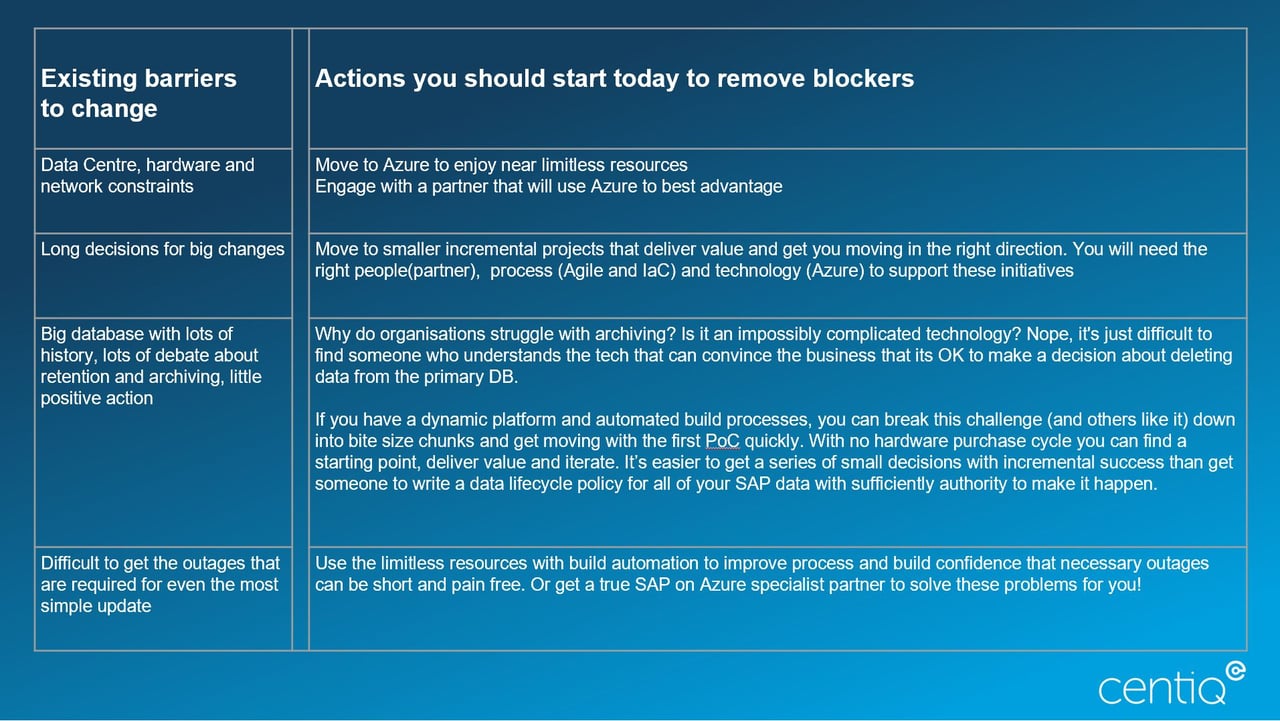Question: How do you minimise value and maximise pain in a project?
Answer: Rush it.
In his entertaining TED talk Inside the mind of a master procrastinator, Tim Urban discusses how he’s never been able to shake his habit of waiting until the last minute to get things done. His graphical representation of this procrastinator trait reminds me of most projects I have ever been associated with.

The SAP ecosystem definitely exhibits this pattern, the decision to migrate to the latest generation of functionality in SAP is a common example. The SAP support window does not move, and the customer avoids the upgrade until they absolutely have to, unable to see any value in doing it sooner.
The assessment of effort involved in the upgrade is overwhelming – functional gap analysis, custom code rework, hardware sizing assessment, hardware selection, partner assessment selection, RFP… the list goes on. Lots of pain and little gain. So, customers avoid the pain and focus on today’s problem and worry about the upgrade somewhere in the future, some in the hope that they will have left or retired before the upgrade needs to be addressed!
The S/4HANA extension – what this means for your business?
Some customers will enjoy the deadline extension from 2025 to 2027 for non S/4HANA workloads. They may not do anything to get themselves closer to S/4HANA in the extra two years it provides.
Customers have scars from previous painful upgrades that delivered little perceived business benefit, or at least that’s how they remember them because all they really remember is the pain it took to get there. It puts them off doing it again. They switch to the if-it-ain’t-broke-don’t-fix-it strategy, and adopt a defiant stance against the perpetrator of the deadline.
The trouble is, it’s a fast-evolving world where competition can go from start-up to a billion-dollar company in a few years. Is it really an option to consider your central ERP system as something that's better left alone? The new kids on the block will almost certainly have a business model that takes advantage of the fast-evolving, interconnected, data-driven world we live in.
Staying still means your competitors will catch you sleeping and steal your market share somewhere in the middle of that long decision cycle.
The pending need to migrate to S/4HANA is a great example of this. Customers waiting for a solid business case to move will be stuck in the decision cycle for some time, and the recent announcement extending the deadline to 2027 I fear will only extend it further.
But what’s the cost of that procrastination?
Every change you make, every config adjustment, every new business process or business unit change or any change that impacts the way you work with your existing SAP ECC system will in some way impact your migration plan for S/4HANA. If you are not thinking about how this decision will improve my chance of migrating to S/4HANA, then the chances are you're making the future migration of S/4HANA harder. Even the growth of the database will make a difference, so putting off that archive project or data/information lifecycle project will have an impact.
History is littered with companies that failed to take advantage of adapting to fast-changing markets: Kodak, Nokia, Xerox all failed to innovate (see another 47 examples here!), don’t become one of the names on the list.
I remember visiting Maplin back in 2011. I was surprised to see how little was being invested in IT modernisation. I suspect the contacts I met were frustrated too!. I was sad when Maplin shut down, but not surprised.
So I repeat, if you are not taking action to move you closer to S/4HANA, you are almost certainly moving further away.
Technical Debt will be an increasing challenge. Your project will become more difficult AND have a more compressed timeline.

As you start to look at the S/4HANA migration path, you will start to unveil other aspects of your SAP systems that need modernisation. Assuming you are not already on HANA, it’s pretty likely there will be some base building blocks within the platform and process that will need resolving before you can start the S/4HANA project, who has 1 TB+ RAM systems waiting for your demand? (hint Azure and other hyperscalers like ..Google ..AWS ). But Technology is only part of the problem, you need to have the right people and process to pull it all together.
The S/4HANA project will be a rollercoaster of a ride and is going to create some significant uncertainty in your journey. You need an agile platform and supporting people to get you there.
Start the journey by removing existing blockers in your landscape that slow the lead time to change.

Let’s be honest, are you really considering a move away from SAP? If the answer is no, then declare it as a strategic decision and work out how to deliver the biggest business benefits from the platform.
The 5 steps
- Start moving in the right direction by creating an Agile culture backed by a flexible SAP platform
- Take advantage of the combined focus of both SAP and Microsoft with the Embrace programme to make Azure your IaaS platform of choice
- Build business value in a series of iterations as you move towards S/4HANA
- Don’t move today’s problems to the next platform
- Don’t leave all of today’s problems to be solved by the one big S/4HANA project in the future.
What are you waiting for? If you have more questions or would like to have a call with our team please send an email here and we can arrange a suitable time.


